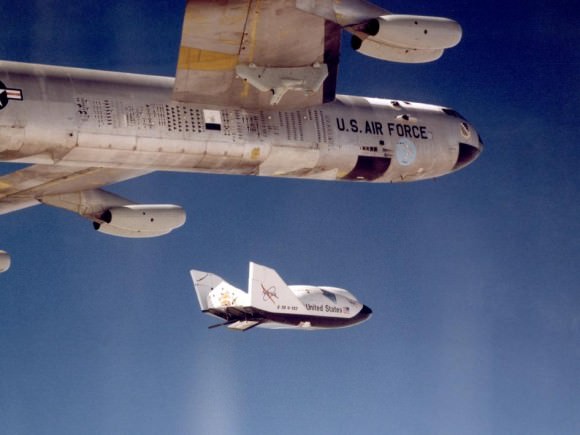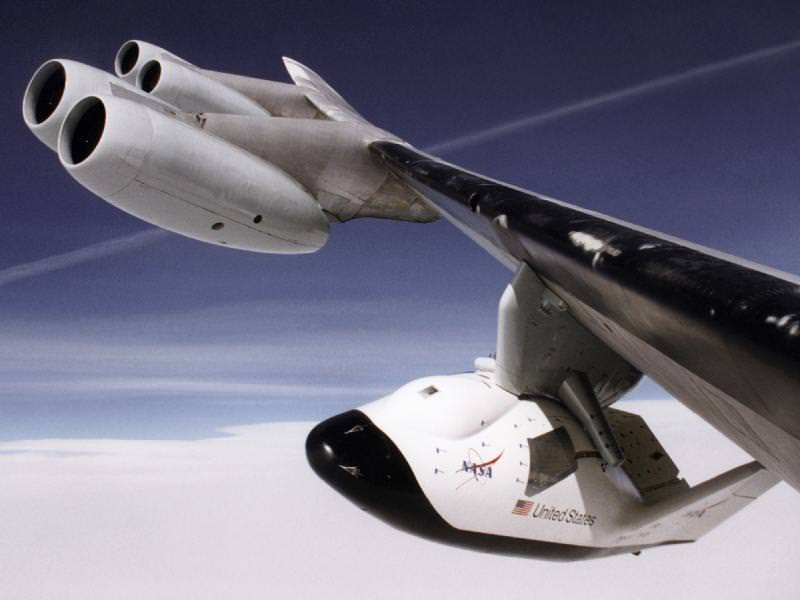[/caption]
Of all the missions and spacecraft that NASA has shelved over the years, I found the X-38 Crew Return Vehicle (CRV) to personally be one of the most disappointing. While its cancellation resulted in no loss of science and never stranded any astronauts in space, my disappointment was from strictly an aesthetic point of view: this was the cutest little spacecraft I had ever seen. The X-38 was a prototype for a wingless lifting body reentry vehicle that was to be used as a crew return and/or rescue vehicle for the International Space Station, but it was canceled in 2002 due to budget cuts. I guess cuteness doesn’t get you far in the space biz.
The image above shows a test flight in 1999 where the the X-38 research vehicle was dropped from a B-52 airplane. Three different designs of the X-38 made flight tests, and the vehicle landed by using one of the biggest aerofoil parachutes ever made. The CRV was designed to fly automatically from orbit to landing using onboard navigation and flight control systems, but backup systems also would have allowed the crew to pick a landing site and steer the parafoil to a landing, if necessary. The X-38’s landed on skids, not wheels, reminiscent of the famed X-15 lifting body research aircraft.
The X-38 was developed at NASA’s Dryden Flight Research Center at Edwards Air Force Base in California, and atmospheric test vehicles were actually built by Scaled Composites – the very same company that later built SpaceShipOne and won the X PRIZE.

The X-38 looks like a mini-space shuttle, and would have fit into the payload bay of the full-size space shuttles.
X-38 weighed 10,660 kg and was 9.1 meters long. The battery system, lasting nine hours, was to be used for power and life support. If the crew from the ISS had to make an emergency return to Earth, it would only take two to three hours for the CRV to reach Earth.
One of the prototypes can now be seen at the Strategic Air and Space Museum in Ashland Nebraska, located just off Interstate 80, about 20 miles southeast of Omaha.
For more info about the X-38, see this NASA webpage.


To me this project seemed much more close to flight readiness when it was canceled compared to the status of Ares I and Orion early this year. So I wonder: isn’t it easier (cheaper) to pick up the work with X-38 where it was left in 2002 and to make this small shuttle a replacement for the Orion rather than to continue with Orion Lite? I’m thinking to launch this shuttle on top of a Delta IV (which is also the first choice for the Orion L too – so it has to be human rated anyway) and to develop/engineer some modifications (perhaps reduce the no. of astronauts ferried from 7 to 4 or 3) in order to be able to stay in orbit with it’s by its own (no ISS power) for 2-3 days, until docking…
I’ve got good news for you, Nancy. See SpaceDev’s Dream Chaser. SpaceDev is a division of Sierra Nevada Corporation in Colorado. They are developing the Dream Chaser, a commercial crew transport vehicle with a design originally derived from the X-38, although it evolved to be more like the NASA HL-20. Check it out: you may decide Dream Chaser is even cuter!
Is easy fly with a parachute 😉
One of Dubya’s many dubious acheivements. Still sticks in my craw.
Cool. Alot of things make it to this prototype phase and get shelved until needed. At first 10,000kg sounds like alot for an escape-craft ,whats that weigh? 22,000lbs guess that isn’t so much, just about as much as a battle loaded black-hawk. Why the parachute? maybe nobody aboard is a pilot? The X-37 is really cool too…I saw a drawing that the cargo doors were removed and men with spacesuits rode inside! Open cockpit in space! Sign me up!
“Dream of empire doesn’t make it so!” … cute or not cute!
Who said that?
Like those chinese pandas. Sure they are cute, but they are also headed for extinction or, at least, never being unable to survive in the wild.
Also knowing the power of the US armed forces, they probably have their own already flying without our knowledge. Duo-goverments existing side by side within one country often means the truth is never absolute. God bless the US military!
Sorry for the cynicism here, but after the “Aurora Alert” story of the 11th November has blunted my cart-blanche believe in the ‘all-knowing” “all dancing” media.
I.e. On the 17th/18th November the prediction that little would be observed proved to be true. Like most news stories, the notification is hailed with fanfare, but when the news proved to be wrong or false, the instigators / perpetrators of the sensationalism are gone with the dust! Worst the story falls off the front page, leaving people who read it far more sceptical and more cynical of science and the scientific methods.
“The X-38 was developed at NASA’s Dryden Flight Research Center at Edwards Air Force Base in California, and atmospheric test vehicles were actually built by Scaled Composites.”
The X-38 atmospheric test vehicles were flight tested at Edwards, and the shells were manufatured by Scaled Components. But all of the vehicle build-up, systems integration, and test was performed at the Johnson Space Center. JSC was also constructing the Space Flight Article, V-201, from the grounf up, or rather from the forward bulkhead back.
The X-37B is kinda cute too? ESPECIALLY when being carried by the White Knight!
http://img1.gtimg.com/tech/pics/32356/32356610.jpg
http://varifrank.com/images/scaled-x37-june_16.jpg
Yes, the X-38 was developed at the Johnson Space Center under the leadership of John Muratore. A lot of the avionics were contributed by ESA so it was a large joint effort. Test versions were airdropped and the proto-flight version was under assembly at JSC. We still have the shell, since ESA took back the avionics, in storage. The CRV was cancelled, and with it the X-38 development version, when the Hab module was also cancelled due to cost over-runs. 🙁 It was a great effort and will go down as one of those projects that almost made it.